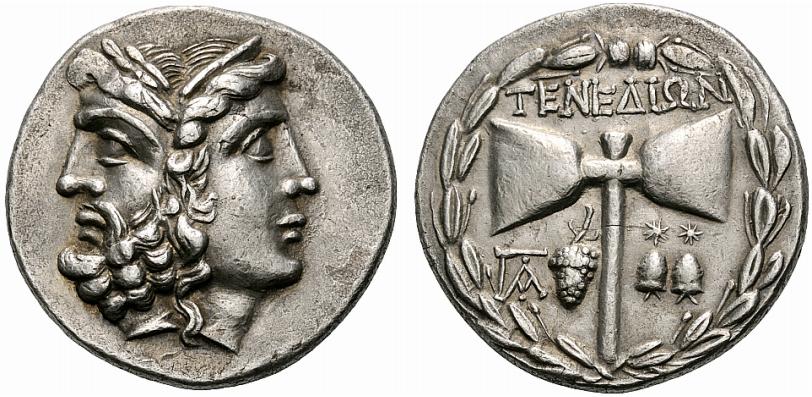
Child graves dated 2,700 years ago have been unearthed from the necropolis site of the ancient Greek city of Tenedos, in modern day Bozcaada district of Çanakkale, Turkey.
The graves belong to children who seem to have died at an early age and were buried placed inside pithoi with their gifts and toys in stone masonry graves.
The excavations in the ancient Greek city of Tenedos – now called Bozcaada – were carried out by archaeologists under Professor Turan Takaoğlu at the Çanakkale Onsekiz Mart University’s Archaeology Department.
Previous excavations in 2023 were conducted in the Bozcaada Castle and then in the necropolis area of the ancient city.
A fact that is of great interest in regards to the child burials is that a previous pithos tomb from the 6th century BC was later placed inside a pithos tomb from the 4th century BC.
Archaeologists have assumed that six terracotta figurines and a horse-foot-shaped bronze pin found in the graves were placed as gifts for the dead in the pithos tomb built later.
Two of these figurines appear to have connections to the cult of Dionysus, the ancient Greek god of festivals and wine. This is evident in their depiction of two dancers adorned in Eastern Phrygian costumes and headgear. Additionally, one figurine portrays a woman playing the lyre, while the remaining three depict standing women.
The particular statuettes indicate that probably the parents of the children made a dedication to god Dionysus and Cybele. The second burial, in the 4th century BC, belongs to the Late Classical Period of Ancient Greece.
The excavation findings underwent restoration and conservation processes and then were delivered to the Troy Museum Directorate.
Ancient Tenedos: A Strategic Connection Between Athens and Bosporus
The ancient Greek island of Tenedos is mentioned in Homer’s Iliad. Situated in close proximity to Troy, it served as the strategic location where the Greeks hid their ships, feigning departure to deceive the Trojans into accepting the Trojan Horse and bringing it within their city walls.
Tenedos controls the southwestern entrance of the Hellespont, from which it is about 12.5 miles (20 kilometers) away. Starting from the 6th century BC, the island expanded its influence to include a piece of land on the opposite shore, which is only three miles (five kilometers) away.
According to Diodorus of Sicily, it was founded by a man named Tenes. Its inhabitants spoke an Aeolian dialect resembling that of people of Lesbos, from which Tenedos was settled.
Due to its strategic position, Tenedos was coveted by many: At the turn of the sixth/fifth century, Athenian commander Miltiades conquered the island; Later, it was conquered by the Persians after the Ionian Revolt; Then Tenedos joined the Delian League; It was sacked by the Spartans during the Corinthian War.
According to historian Brian Rutishauser, during the Classical Period the island of Tenedos appears to have been an important ally of Athens because its strategic position placed it on the grain route from the Bosporus to Athens.
During the 4th century BC, the Tenedians appear to have taken advantage of their
political and economic position and managed to have an influential position in the Second Athenian League and may have expanded their territory on the mainland of Asia Minor.
During the 5th century AD, the Byzantine Emperor Justinian ordered the construction of a granary on Tenedos to accommodate supplies coming from Egypt to Constantinople.
Procopius wrote that grain ships were often prevented from entering the Hellespont until a wind blowing from the south appeared. The granary was intended to be a temporary storehouse so that the grain fleet could make several trips to Egypt and back during the sailing season, while other vessels could then shuttle the grain to Constantinople when the winds were favorable again.
Modern Day Tenedos
Following the 1923 Lausanne Treaty (art. 14), Turkey was granted the sovereignty of Tenedos under a “special administrative organization composed of local elements and furnishing every guarantee for the native non-Muslim population in so far as concerns local administration and the protection of person and property.”
However, these provisions were never implemented by Turkey. In 1923, at the height of Turkish nationalism, the persecution of Greeks in Turkey continued despite the Lausanne Treaty. As early as 1927, most of the buildings of the island were demolished and a massive colonization of people from the Turkish hinterland went into effect. The island population was gradually altered, along with the expropriation of properties belonging to Greeks.
Reaching its peak in the mid-1950s, the situation escalated to the point where, on July 1, 1964, the teaching of Greek in schools on Tenedos was prohibited. This measure aimed to bring about a demographic shift on the island, coinciding with the expulsion of a significant number of Greeks residing in Constantinople (Istanbul) during the same period.
Many Greeks fled the island. Others refused to leave their homes. Yet many Greeks withstood, with the mother tongue still being spoken. In the late 2010s, the Greek population of Tenedos was greatly reduced, amounting to about 30 elderly people.
See all the latest news from Greece and the world at Greekreporter.com. Contact our newsroom to report an update or send your story, photos and videos. Follow GR on Google News and subscribe here to our daily email!



